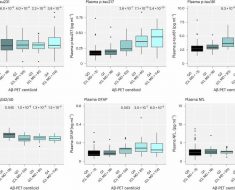- Researchers say children of mothers who experience depression are more likely to develop depression as they get older.
- The results from their study indicate that more programs are needed to treat mothers for prenatal and postnatal depression.
- Experts say a healthy family lifestyle can lower the risk of depression for children.
Children of mothers who experienced perinatal depression have a 70 percent higher risk of developing depression in adolescence and adulthood.
That’s the conclusion from a
In the study, researchers in the United Kingdom and North America examined data collected from nearly 16,000 mother-child dyads. The children were ages 12 and older.
Female adolescents in the study were found to have a 6 percent higher risk of depression compared to males whose mothers experienced perinatal depression.
The study suggests that additional research into the mechanisms of depression risk transmission and assessments of postinterventional risk reduction could pave the way for new strategies that reduce risks of depressive disorders during pregnancy.
Perinatal depression explained
“Perinatal depression simply isn’t talked enough about and there is still a lot of stigma attached to it,” said Dr. Roseann Capanna-Hodge, a psychologist and pediatric mental health expert with offices in Connecticut and New York.
Perinatal depression refers to a depressive episode during pregnancy (antenatal depression) or within 12 months after pregnancy (postnatal depression).
This mood disorder ranges from mild to severe and is treatable, according to the National Institute of Mental Health.
“We paint the picture that having a newborn is sunshine and roses, but
“For a new mom, they feel guilty about being sad after having this baby that they so desperately wanted and some moms may not even recognize their depression,” she added.
What experts have to say
None of the experts Healthline spoke with were surprised by the study’s findings.
“I guess 70 percent is rather high, but that it is significant doesn’t surprise me,” said Dr. Alexandra Stockwell, a relationship and intimacy expert and author of “Uncompromising Intimacy.”
She explained how intersecting factors influence this finding.
“Our culture is sorely lacking in the appreciation of the emotional, physical, and spiritual passage into motherhood,” Stockwell told Healthline. “We no longer understand the importance of mothering the mother and that creates all kinds of challenges for mom-child dyads.”
“The age-old conundrum of nurture versus nature pertains here, where the mother’s perinatal depression functions as a ‘nurture’ influence,” she said.
Stockwell added that mammals, including humans, learn through imitation.
“Children learn all kinds of things from parents, starting at a young age — some we have been able to quantify and some not,” she said.
“The imprinting begins immediately,” she added. “So even if there wasn’t a genetic disposition, and other very important biological/physiological considerations, children who are raised by parents with a mood disorder early on (and later, too), are at risk for feeling that way too.”
Capanna-Hodge added that
“More specifically, research has demonstrated that when infants try to engage with a mother who displays a flat affect and thereby doesn’t engage in a responsive manner to an infant’s interactions leads to infant distress,” she said.
“Maternal depression disrupts the development of infant emotion regulation and the current meta-analysis goes one step further and demonstrates the long-term implications of perinatal depression on child mental health,” she added.
Reducing the risks
Biological and environmental factors can influence mental health, especially with bodily changes related to pregnancy and delivery, said Erin Sadler, PsyD, a licensed clinical psychologist in the division of psychology and behavioral health at Children’s National Hospital in Washington, D.C.
“Working with a therapist trained in perinatal depression and child development who can coach a parent can make the world of difference for the mother, the child, and the whole family,” said Stockwell.
However, interventions for risk reduction can be helpful during any stage of pregnancy.
Experts told Healthline that, in general, the same measures for lowering the risk of depression in adults can be applied to help reduce risk of maternal depression.
This means getting adequate sleep, nutrition, activity, staying hydrated, spending time in nature, and asking for help — peer or professional — when needed.
Sadler told Healthline there are additional ways to reduce risk for mother-child dyads.
Prenatal support
“In recent years, we’ve seen a large push for universal screenings for depression in caregivers (primarily mothers) during pregnancy, and this is truly a great start,” Sadler said.
Early detection in caregivers is a vital form of early intervention for children as well, she noted.
“For parents and adults, it’s important to recognize your own personal risk factors,” said Sadler. “Talk to your family members about a history of mental health disorders, giving special attention to mood and anxiety disorders.”
“Be honest. Be vigilant,” she said.
“With comprehensive care systems, such as integrated behavioral health programs, pregnant women can receive mental health support alongside their physical medical care,” Sadler added.
She said this should include having mental health professionals such as licensed clinical social workers, psychologists, and psychiatrists integrated into women’s health clinics and working as part of the care teams.
“Additionally, mothers should have access to support staff, such as case managers, who are able to ensure continuity of care by connecting families to support after delivery and upon return home,” said Sadler.
“It’s important to note that these supports are not limited to mental health support, but other foundation needs such as housing, food, financial, and other support programs,” she added. “These programs can relieve stressors, making caregivers more available to provide emotional care to their children.”
Decreasing barriers to these services is critical for risk reduction.
Postnatal support
Sadler said postnatal support can look like targeted therapeutic services to treat depression. For example, psychotherapy and medication.
“Considering the implication of maternal depression on infant-child attachment relationships, families should be referred to programs that are able to provide perinatal and infant mental health specialized support,” said Sadler. “Providers trained to address attachment challenges and prevent lasting effects of social/emotional challenges are imperative.”
In addition, she said postpartum doulas can provide meaningful, functional, in-home support to mothers in the immediate postpartum period.
“When caregivers are taken care of, they have a great capacity to care for their young children,” she said.
Knowing the signs reduces risk
Sadler explained that depression across the lifespan doesn’t always manifest itself in the same way.
Therefore, signs of depression in offspring may be missed or misinterpreted as other problems.
“Remember that emotion regulation during this time is a dyadic process. Thus, we expect young children to depict a wide range of emotions,” said Sadler.
Knowing the signs of depression throughout life stages is critical for early intervention.
Recent research has shown early interventions can help reduce the risk of youth and adult suicide.
Sadler lists the following tell-tale signs of depression:
Infancy and early childhood (ages 0–5)
- prolonged sadness or irritability in combination with disruptions in other areas such as sleep, poor appetite, and little activity
- limited or low engagement, responsibility, and reciprocity with caregivers and others
- delayed achievement or regression of developmental milestones
Childhood
- expressed guilt or low self-esteem and self-efficacy
- somatic complaints, such as headaches, stomachaches, or feeling ill
- irritability via tantrums or other behavior problems
Adolescence
- withdrawal from adults but may still spend time with close friends
- for teens, emotional changes expressed via irritability or anger (in lieu of a sad or down mood)
- poor sleep hygiene (getting limited sleep and at varied hours)
Adulthood
- emotions more typically expressed as a sad or down mood
- insomnia in lieu of poorly regulated sleep
- isolation and withdrawal from others
If caregivers have concerns or notice changes in their child’s behaviors, Sadler said they should proactively seek support from a professional.
“Pediatricians are often the first stop for many parents,” she said.
“Schools can also be a great first line for children and teens as well. However, caregivers can always directly pursue mental health providers to assess the concerns and make recommendations,” she added. “Find care providers you trust, collaborate in developing treatment plans, and follow recommendations.”
Moreover, family units can foster lifestyles that combat depressive symptoms at home.
Sadler said this family lifestyle includes:
- Regular involvement in activities that bring about positive emotions. These will vary for each individual, so plans should cater to all family members.
- Maintaining a balanced, healthy diet. Parents and caregivers can work with pediatricians or dietitians if additional guidance is needed.
- Prioritizing developmentally-appropriate sleep hygiene. Poor sleep can impact a person’s mood, concentration, distress tolerance, and problem solving.
- Seek support from care providers as needed.
- Use social support and continue participating in extracurricular activities that promote the development of positive peer relationships.
- Caregivers should remain in contact with other care providers (e.g. pediatricians, school teachers, coaches, etc.) as these stakeholders can also have valuable insight into how a child is functioning.

Source: Read Full Article





